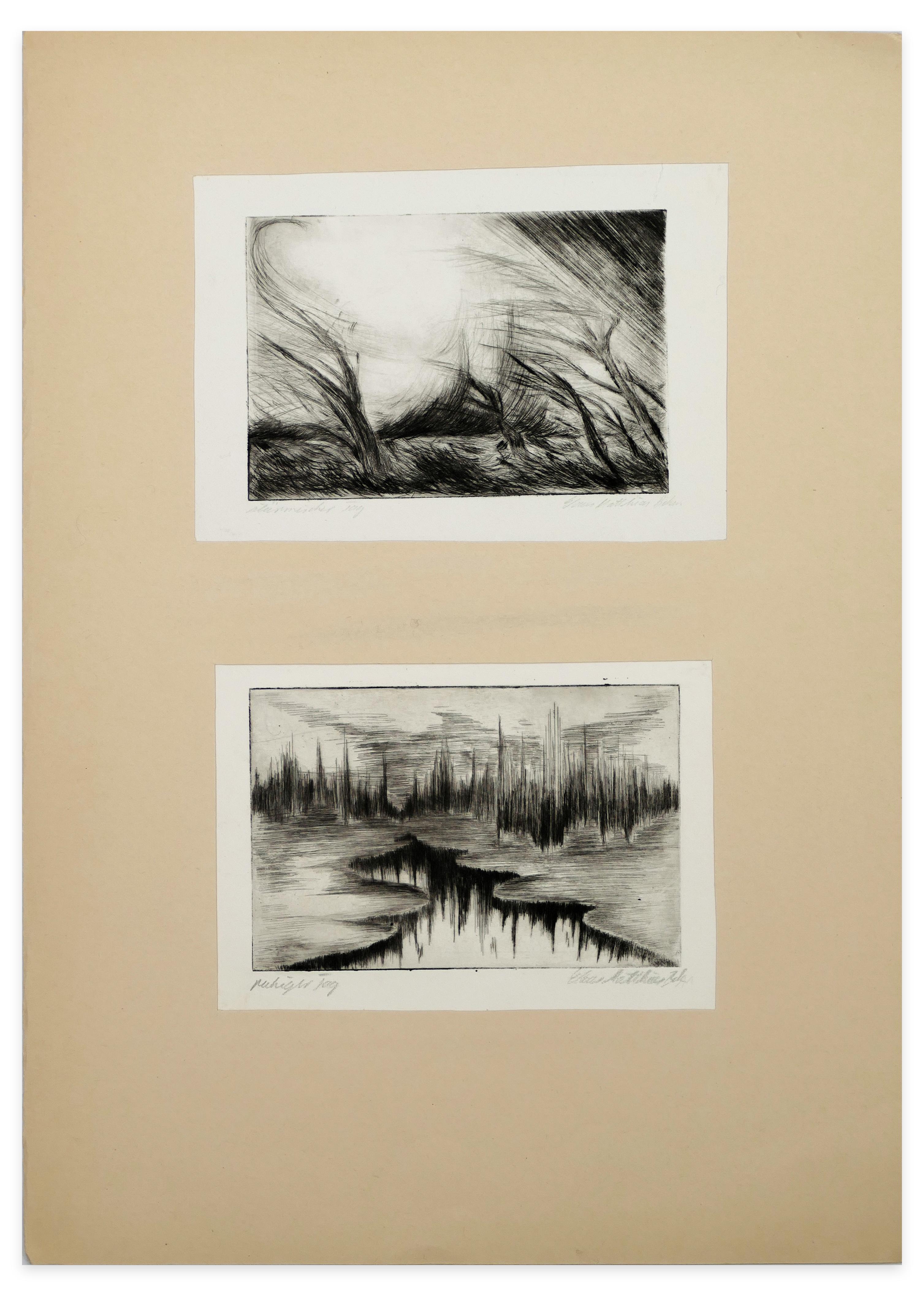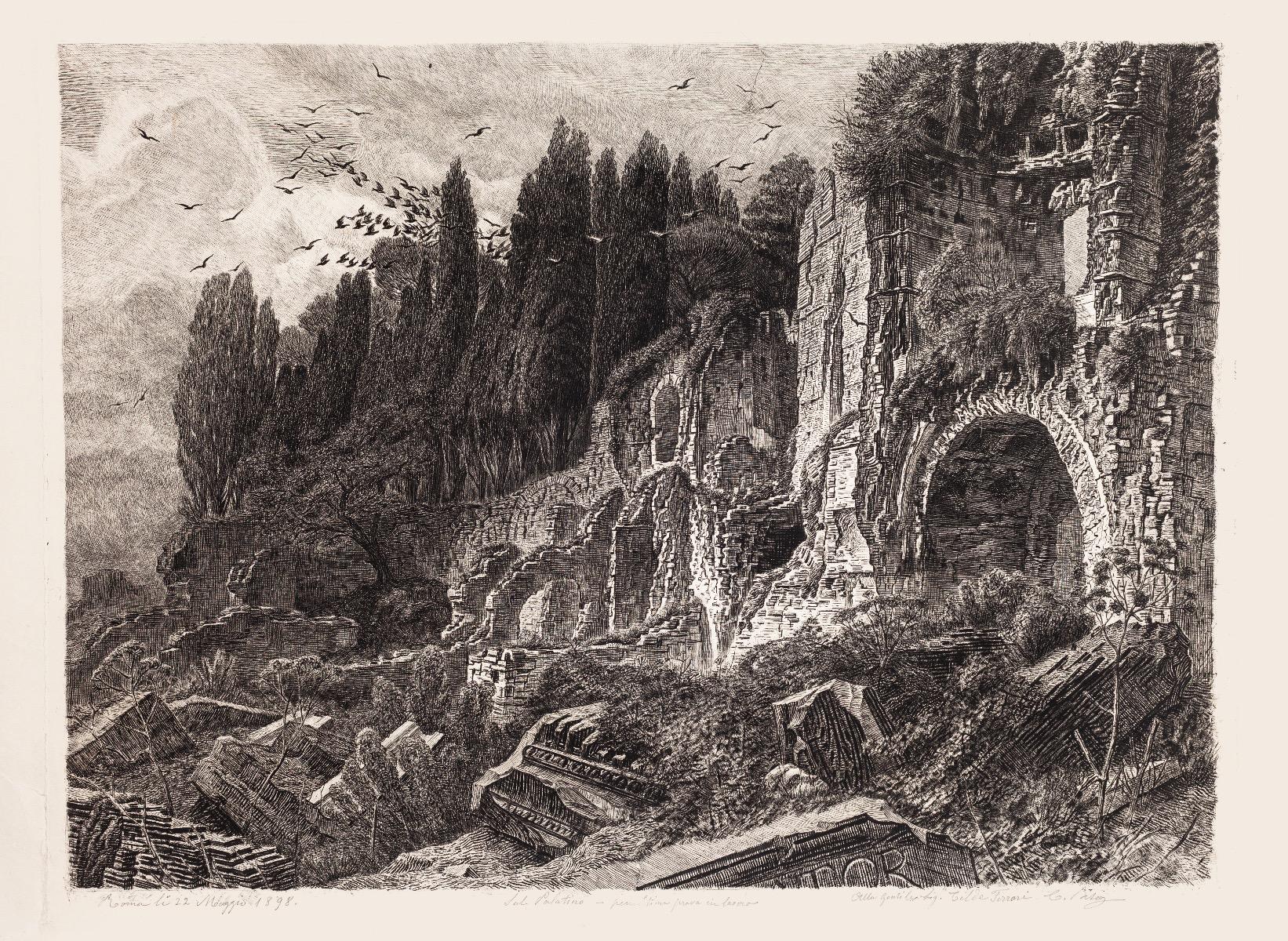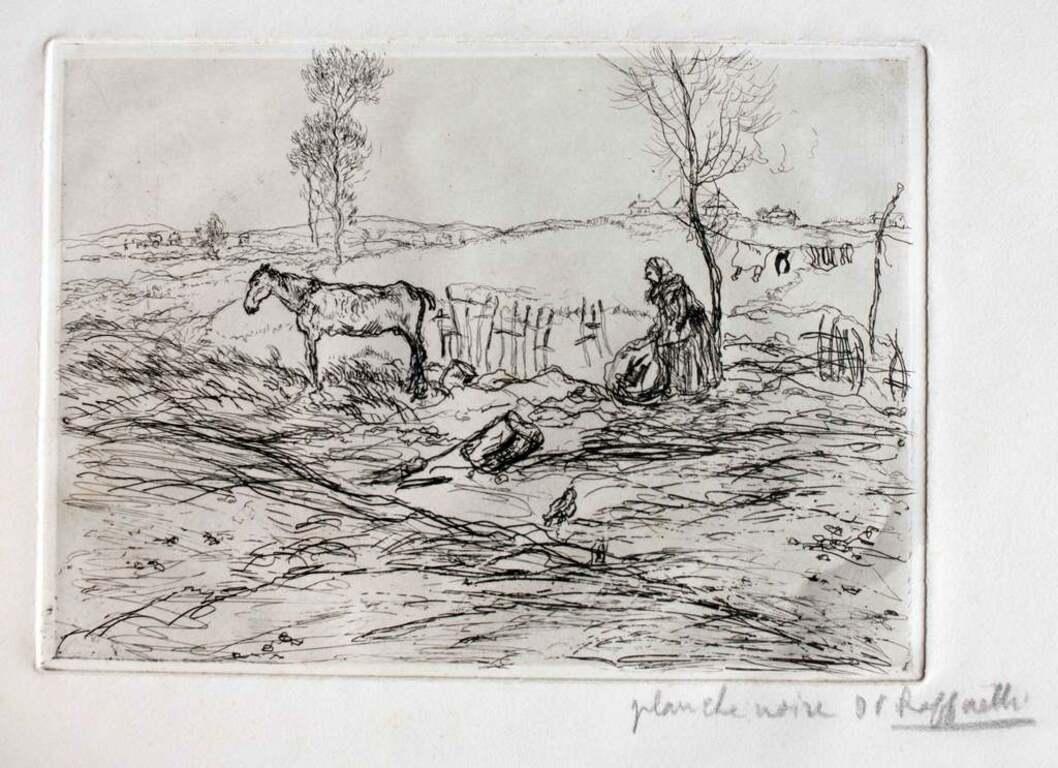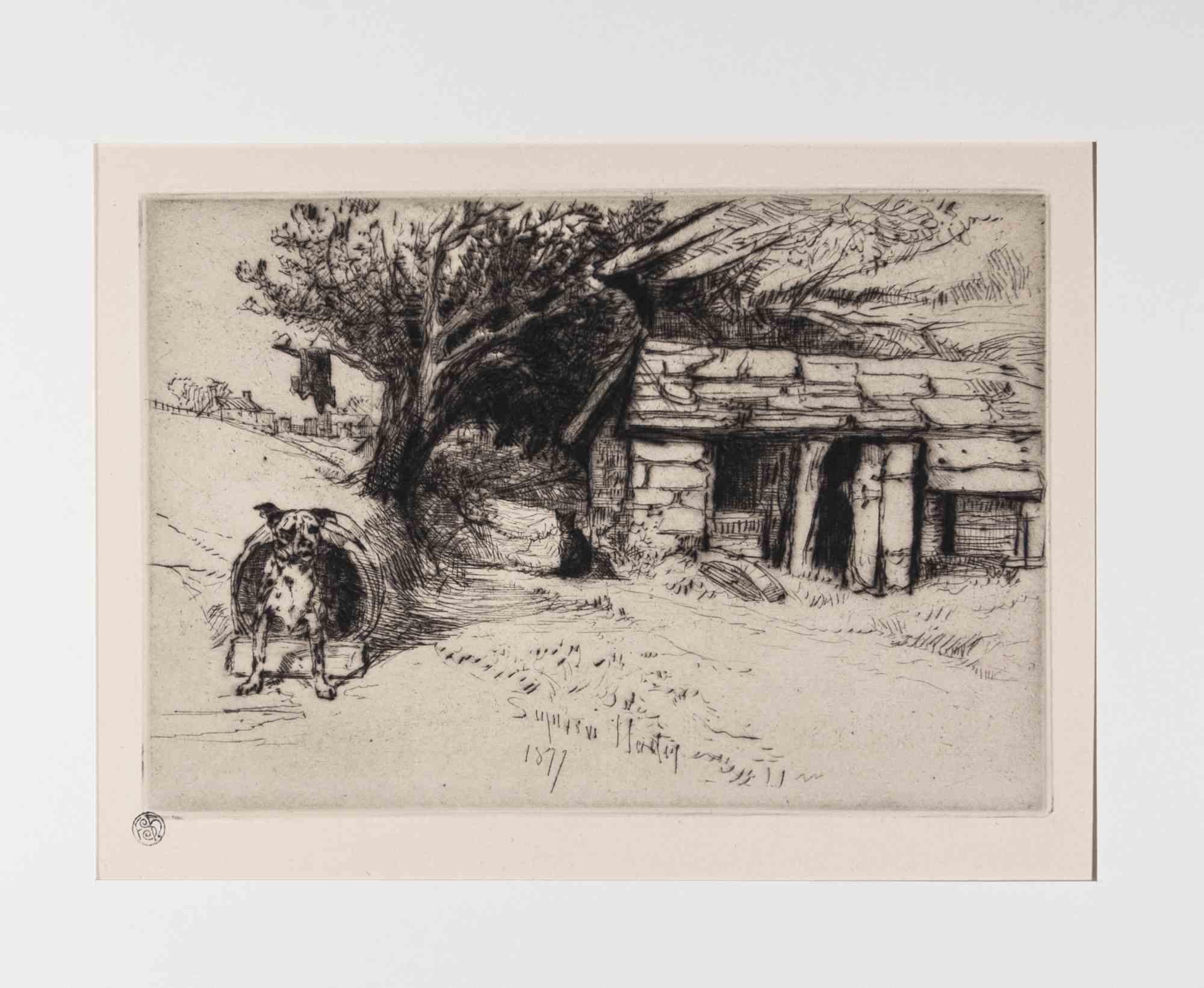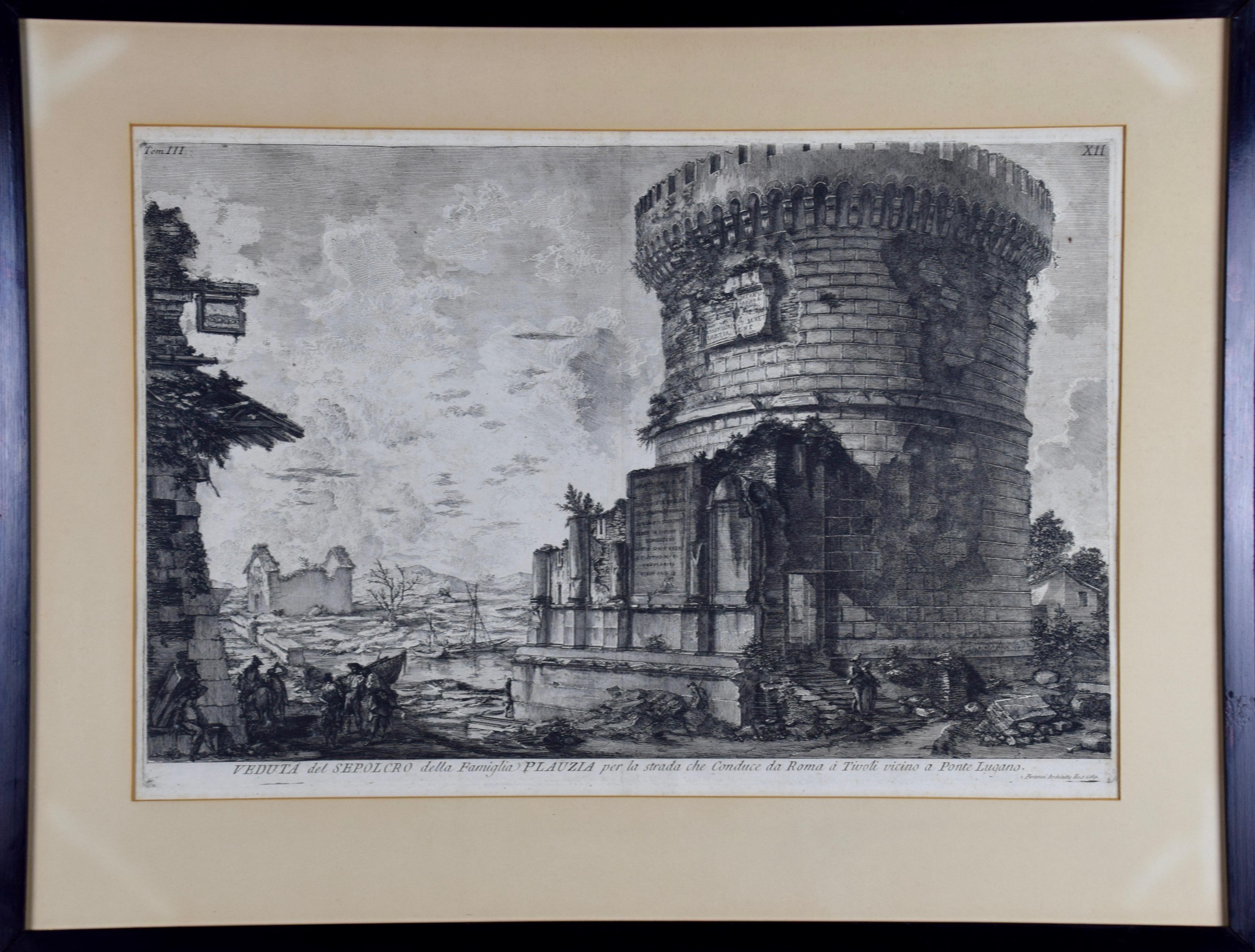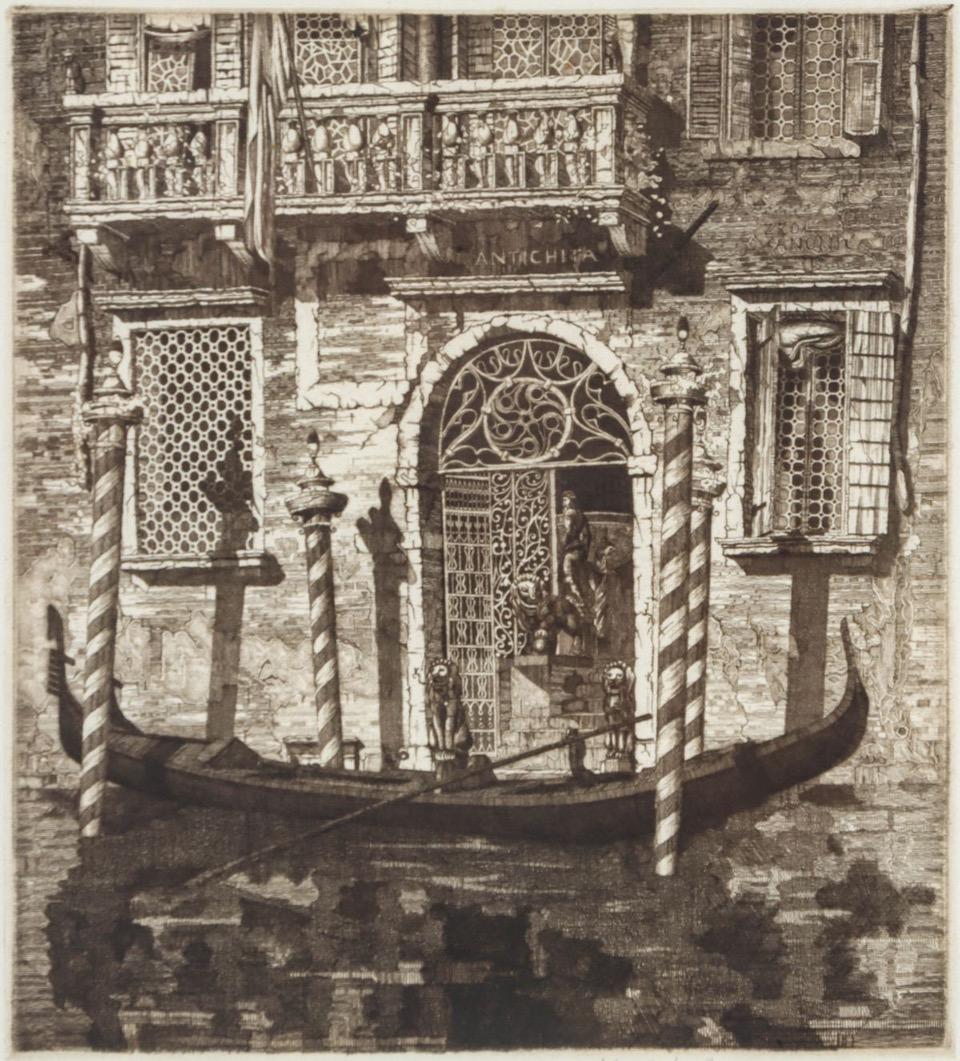Items Similar to Poggio a Caiano - Etching and Drypoint by A. Soffici - 1964
Want more images or videos?
Request additional images or videos from the seller
1 of 6
Ardengo SofficiPoggio a Caiano - Etching and Drypoint by A. Soffici - 19641964
1964
About the Item
Poggio a Caiano is an original black and white etching realized by Ardengo Soffici in 1964.
Hand written dedication on the right margin "Per Ardengo Soffici, Maria Soffici".
Numbered on the lower left.
Edition of 102 copies (16/102), etching on copper.
Signed on plate.
This is one artwork collected in the portfolio "Galleria Grafica Contemporanea", published by Associazione Nazionale per l'Assistenza agli Spastici, Firenze, 1964.
- Creator:Ardengo Soffici (1879 - 1964)
- Creation Year:1964
- Dimensions:Height: 25.6 in (65 cm)Width: 18.12 in (46 cm)Depth: 0.08 in (2 mm)
- Medium:
- Period:
- Framing:Framing Options Available
- Condition:Insurance may be requested by customers as additional service, contact us for more information.
- Gallery Location:Roma, IT
- Reference Number:
Ardengo Soffici
Ardengo Soffici was an Italian painter, intellectual, poet and writer. He was an exponent of Futurism even if his relationship with the movement had some moments of hostility. In 1913, Soffici founded with Papini the Futurist magazine Lacerba where he published "Theory of the movement of plastic Futurism."
About the Seller
4.9
Platinum Seller
These expertly vetted sellers are 1stDibs' most experienced sellers and are rated highest by our customers.
1stDibs seller since 2017
6,822 sales on 1stDibs
Typical response time: 3 hours
- ShippingRetrieving quote...Ships From: Rome, Italy
- Return PolicyA return for this item may be initiated within 14 days of delivery.
More From This SellerView All
- Two Lake Landscapes - Original Etching and Drypoint - 1970sLocated in Roma, ITImage dimensions: 10 x 14.8 cm. Two Lake Landscapes are the subjects on these two original black and white etchings and drypoint on paper,l realized by a German artist whose signatu...Category
1970s Landscape Prints
MaterialsEtching, Drypoint
- Rome, Palatine Hill - Original Etching and Dry-point by Cesare Biseo - 1898Located in Roma, ITRome, Palatine Hill is a wonderful etching and dry-point on paper by realized by Cesare Biseo in 1898. Hand-signed and dated with the description on the lower in pencil. In very go...Category
1890s Figurative Prints
MaterialsEtching, Drypoint
- Landscape - Etching by J. F. Raffaelli - Late 19th CenturyBy Jean-Francois RaffaelliLocated in Roma, ITEtching and drypoint. Hand signed. Very good condition.Category
Late 19th Century Modern Figurative Prints
MaterialsDrypoint, Etching
- The Cabin - Drypoint by Francis Saymour-Haden - 1877Located in Roma, ITThe Cabin is an original Modern artwork realized by Sir Francis Saymour-Haden (16 September 1818 – 1 June 1910) in 1877. Beautiful Proof on vélin fort, with stamp "Lugt 1048”. Full ...Category
1870s Modern Figurative Prints
MaterialsEtching, Drypoint
- Landscape - Etching and Drypoint by Edmone A. Ades - Mid 20th CenturyBy Edmone A. AdesLocated in Roma, ITLandscape is a black and white print realized by Edmone A. Ades in the First Half 20th Century. Etching and drypoint. The artwork represents a landscape. Hand-signed on the lower ...Category
Mid-20th Century Figurative Prints
MaterialsEtching, Drypoint
- At the Beach - Drypoint and Etching by Mino Maccari - Mid-20th CenturyBy Mino MaccariLocated in Roma, ITAt the Beach is an original Etching and Drypoint realized by Mino Maccari in Mid-20th Century. Good condition on a yellowed paper. Hand-signed by the artist with pencil. Mino Macc...Category
Mid-20th Century Modern Figurative Prints
MaterialsEtching, Drypoint
You May Also Like
- Giovanni Piranesi Etching of Ancient Roman Architecture, 18th CenturyBy Giovanni Battista PiranesiLocated in Alamo, CA"Veduta del Sepolcro della Famiglia Plauzia per la Strada Che Conduce da Roma a Tivoli vicino a Ponte Lugano" from "Le Antichità Romane" (Roman Antiquities), one of the most famous works by Piranesi. "Antichita" illustrates the tombs along the Appian Way...Category
Early 18th Century Old Masters Figurative Prints
MaterialsDrypoint, Engraving, Etching
- Palazzo dell'AngeloBy John Taylor ArmsLocated in Middletown, NYPalazzo dell'Angelo 1931 Etching and drypoint on cream-colored, handmade laid paper with deckle edges, 7 1/4 x 6 3/4 inches (185 x 171 mm), edition of 100, full margins. Signed, dated and numbered "Ed. 100" in pencil, lower margin, second state (of three). Printed by Henry Carling, New York. Extremely minor mat tone and some inky residue in the top right corner, all unobtrusive and well outside of image area. An exquisite impression of this intricate image, with astonishing detail, and all the fine lines printing clearly. The image represents the first print which Arms printed on his own handmade paper. Framed handsomely with archival materials and museum grade glass in a wood gilt frame with a flower and garland motif. Illustrated: Dorothy Noyes Arms, Hill Towns and Cities of Northern Italy, p. 180; Anderson, American Etchers Abroad 1880-1930; Eric Denker, Reflections & Undercurrents: Ernest Roth and Printmaking in Venice, 1900-1940, p. 116. [Fletcher 233] Born in 1887 in Washington DC, John Taylor Arms studied at Princeton University, and ultimately earned a degree in architecture at the Massachusetts Institute of Technology in 1912. With the outbreak of W.W.I, Arms served as an officer in the United States Navy, and it was during this time that he turned his focus to printmaking, having published his first etching in 1919. His first subjects were the Brooklyn Bridge, near the Navy Yard, and it was during his wartime travel that Arms created a series of extraordinarily detailed etchings based on Gothic cathedrals and churches he visited in France and Italy. He used what was available to him, namely sewing needles and a magnifying glass, to create the incredibly rich and fine detail that his etchings are known for. Upon his return to New York after the war, Arms enjoyed a successful career as a graphic artist, created a series of etchings of American cities, and published Handbook of Print Making and Print Makers (Macmillan, 1934). He served as President of the Society of American Graphic Artists, and in 1933, was made a full member of the National Academy of Design. In its most modern incarnation, Palazzo dell'Angelo was constructed in or around 1570. The building, which has a rich and storied history, was erected upon the ruins of an earlier structure which predates the Gothic period. Some remnants of the earliest features of the residence were most certainly still visible when Arms visited, as they are today. Having a background in architecture, there's no question that Arms was moved by the beauty, history and ingenuity represented in the physical structure. One thing specifically gives away Arms's passion for the architecture, and that is the fact that he focused on the building's Moorish entranceway, balustrade, and two mullioned windows, and not on the curious Gothic era bas-relief of an angel nestled into the facade of the building, after which the structure is named. The sculpture itself doesn't appear in Arms's composition at all, despite the fact that it is the feature of the building that is most famous in its folklore. Arms instead focuses on the oldest portion of the architecture, even documenting some of the remnants of a fresco, and a funerary stele for the freedman Tito Mestrio Logismo, and his wife Mestria Sperata (visible above the water level, to the left of the door, behind the gondola), which was first described in 1436. Among the many notable bits of history regarding the Palazzo, it has been documented that Tintoretto painted frescos of battle scenes on the facade of the building. The paintings have been lost to time and the elements, but not entirely to history. The empty frame...Category
1930s American Modern Figurative Prints
MaterialsEtching, Drypoint
- La petite marine -- Souvenir de Medway. (Little Seascape, a Remembrance of the MBy Félix Hilaire BuhotLocated in Storrs, CTLa petite marine -- Souvenir de Medway. (Little Seascape, a Remembrance of the Medway). 1879. Etching, drypoint, false biting, aquatint, and stop-out. Bourcard-Goodfriend catalog 15...Category
1870s Modern Landscape Prints
MaterialsDrypoint, Etching, Aquatint
- Make Fast, Plate 2.By Arthur John Trevor BriscoeLocated in Storrs, CTMake Fast, plate 2. 1929. Etching. Laver catalog number 146; Hurst catalog number 258. Plate: 14 3/8 x 9 13/16 (sheet 17 5/8 x 11 3/4). Trial proof 2, before the edition or 75. Ill...Category
1920s Modern Landscape Prints
MaterialsDrypoint, Etching
- Irving Guyer, Christmas Trees on Second Street (NYC)By Irving GuyerLocated in New York, NYPhiladelphia-born Irving Guyer attended the Art Students League and worked in New York City before moving to California. This print is signed and titled i...Category
1930s American Modern Figurative Prints
MaterialsEtching, Drypoint
- The Venetian MastBy James Abbott McNeill WhistlerLocated in Storrs, CTThe Venetian Mast. 1879-80. Etching and drypoint. Kennedy catalog 195 state .vi; Glasgow catalog 219 state x/xii. 13 3/8 x 6 3/8. Glasgow records 53 impressions. A fine, atmospheric...Category
1870s American Impressionist Landscape Prints
MaterialsDrypoint, Etching
Recently Viewed
View AllMore Ways To Browse
Vintage Copper Sign
Firenze Plate
Used Wedding Hats
Vienna Vintage Travel Poster
Vintage Clothing 1930s 1940s
Vintage Native American Posters
19th Century Judaica
19th Century Painting Lovers
Antique Illustrated Bible
Cemetery Cross
Cocteau Original Drawing
Cubist Harbor
Dali Persistence
Dior Honore
Dior Scharf
Giacomo Manzu
Hans Pick
Keener Anna
